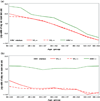Longitudinal Trends in Sexual Behaviors with Advancing Age and Menopause Among Women With and Without HIV-1 Infection
- PMID: 25245474
- PMCID: PMC4370800
- DOI: 10.1007/s10461-014-0901-1
Longitudinal Trends in Sexual Behaviors with Advancing Age and Menopause Among Women With and Without HIV-1 Infection
Abstract
We assessed changes in self-reported sexual activity (SA) over 13 years among HIV-infected and uninfected women. The impact of aging and menopause on SA and unprotected anal or vaginal intercourse (UAVI) was examined among women in the Women's Interagency HIV Study (WIHS), stratifying by HIV status and detectable viral load among HIV-infected women. Generalized mixed linear models were fitted for each outcome, adjusted for relevant covariates. HIV-uninfected women evidenced higher levels of SA and UAVI than HIV-infected. The odds of SA declined by 62-64 % per decade of age. The odds of SA in a 6-month interval for women aged 40-57 declined by 18-22 % post-menopause (controlling for age). Among HIV+/detectable women only, the odds of any UAVI decreased by 17 % per decade of age; the odds of UAVI were unchanged pre-menopause, and then decreased by 28 % post-menopause. Elucidating the factors accounting for ongoing unprotected sex among older women should inform interventions.
Figures


Similar articles
-
Sexual serosorting among women with or at risk of HIV infection.AIDS Behav. 2011 Jan;15(1):9-15. doi: 10.1007/s10461-010-9710-3. AIDS Behav. 2011. PMID: 20490909 Free PMC article.
-
Examining the role of serostatus disclosure on unprotected sex among people living with HIV.AIDS Patient Care STDS. 2014 Dec;28(12):677-84. doi: 10.1089/apc.2014.0203. AIDS Patient Care STDS. 2014. PMID: 25397358 Free PMC article.
-
Patterns and predictors of high-risk sexual behavior in female partners of HIV-infected men with hemophilia.AIDS. 1992 May;6(5):475-82. doi: 10.1097/00002030-199205000-00006. AIDS. 1992. PMID: 1616653
-
Daily associations between alcohol use and unprotected anal sex among heavy drinking HIV-positive men who have sex with men.AIDS Behav. 2015 Mar;19(3):422-30. doi: 10.1007/s10461-014-0896-7. AIDS Behav. 2015. PMID: 25194967 Free PMC article. Review.
-
HIV and Aging Research in Women: An Overview.Curr HIV/AIDS Rep. 2016 Dec;13(6):383-391. doi: 10.1007/s11904-016-0338-4. Curr HIV/AIDS Rep. 2016. PMID: 27771876 Review.
Cited by
-
Healthy Aging in Older Women Living with HIV Infection: a Systematic Review of Psychosocial Factors.Curr HIV/AIDS Rep. 2017 Feb;14(1):17-30. doi: 10.1007/s11904-017-0347-y. Curr HIV/AIDS Rep. 2017. PMID: 28194650 Free PMC article.
-
"The Pleasure Is Better as I've Gotten Older": Sexual Health, Sexuality, and Sexual Risk Behaviors Among Older Women Living With HIV.Arch Sex Behav. 2017 May;46(4):1137-1150. doi: 10.1007/s10508-016-0751-1. Epub 2016 May 24. Arch Sex Behav. 2017. PMID: 27220311 Free PMC article.
-
Trends in Bacterial Vaginosis Prevalence in a Cohort of U.S. Women with and at Risk for HIV.J Womens Health (Larchmt). 2022 May;31(5):726-732. doi: 10.1089/jwh.2021.0102. Epub 2021 Aug 27. J Womens Health (Larchmt). 2022. PMID: 34449258 Free PMC article.
-
Ageing and healthy sexuality among women living with HIV.Reprod Health Matters. 2016 Nov;24(48):43-51. doi: 10.1016/j.rhm.2016.11.001. Epub 2016 Nov 26. Reprod Health Matters. 2016. PMID: 28024676 Free PMC article.
-
Attitudes toward Menopause in HIV-Infected Cambodian Women.Healthcare (Basel). 2021 Jun 4;9(6):677. doi: 10.3390/healthcare9060677. Healthcare (Basel). 2021. PMID: 34200010 Free PMC article.
References
-
- Reece M, Herbenick D, Schick V, Sanders SA, Dodge B, Fortenberry JD. Condom use rates in a national probability sample of males and females ages 14 to 94 in the United States. J Sex Med. 2010;7(s5):266–276. - PubMed
-
- Schick V, Herbenick D, Reece M, Sanders SA, Dodge B, Middlestadt SE, Fortenberry JD. Sexual behaviors, condom use, and sexual health of Americans over 50: implications for sexual health promotion for older adults. J Sex Med. 2010;7(s5):315–329. - PubMed
Publication types
MeSH terms
Grants and funding
- K01 MH095670/MH/NIMH NIH HHS/United States
- U01-AI-034994/AI/NIAID NIH HHS/United States
- U01 AI031834/AI/NIAID NIH HHS/United States
- L30 AG043169/AG/NIA NIH HHS/United States
- U01-AI-034993/AI/NIAID NIH HHS/United States
- U01 AI034989/AI/NIAID NIH HHS/United States
- U01-AI-035004/AI/NIAID NIH HHS/United States
- 1 KO1 MH095670/MH/NIMH NIH HHS/United States
- U01 AI034994/AI/NIAID NIH HHS/United States
- U01 AI034993/AI/NIAID NIH HHS/United States
- UL1 TR000004/TR/NCATS NIH HHS/United States
- UL1-TR000004/TR/NCATS NIH HHS/United States
- U01 AI035004/AI/NIAID NIH HHS/United States
- U01-AI-034989/AI/NIAID NIH HHS/United States
- U01-AI-042590/AI/NIAID NIH HHS/United States
- U01-HD-032632/HD/NICHD NIH HHS/United States
- U01-AI-031834/AI/NIAID NIH HHS/United States
- U01 HD032632/HD/NICHD NIH HHS/United States
- U01 AI042590/AI/NIAID NIH HHS/United States
LinkOut - more resources
Full Text Sources
Other Literature Sources
Medical

